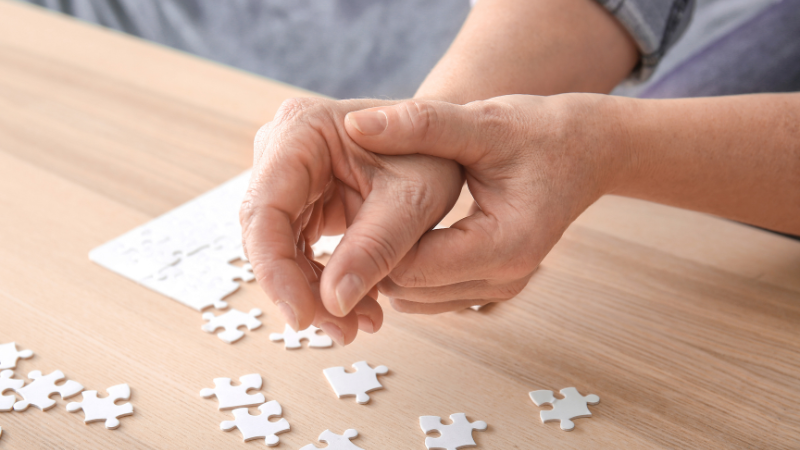In this article
ToggleWith an ageing population, neurodegenerative disorders like Parkinson’s disease and dementia are likely to become more common. Though some therapies exist, we can’t currently prevent or cure neurodegenerative disorders. So, what is brain therapy and what role does it play in the therapy of Parkinson’s disease and dementia?
What is brain therapy?
Brain-based therapies use the science of neuroplasticity to remould your brain. Whenever you learn a new skill, you’re creating new neural pathways and changing the structure of your brain.
When given the right stimulation, your brain’s nerve cells can expand and communicate with new nerve cells. Brain-based therapy involves a mix of activities designed to provide that stimulation.
The goal is to help restore brain balance – the left and right sides of your brain working closely together in equal partnership.
Brain imbalances lie behind many neurological conditions. For example, patients with Parkinson’s disease often have a brain imbalance (or hemispheric asymmetry). Specific, targeted activities can help to improve function.
Benefits of light therapy for Parkinson’s
Light therapy (phototherapy) has a long use in medicine. Indeed, the 1903 Nobel Prize in Physiology was awarded to a Scandinavian doctor who had successfully treated skin conditions using light therapy.
Light can directly affect the dopamine system and this may be the means by which it improves Parkinson’s disease symptoms. Light therapy for Parkinson’s disease is a non-invasive approach that may help improve:
- Sleep
- Anxiety and depression
- Fatigue
- Motor function.
To date, there have been 9 clinical trials into light therapy for Parkinson’s disease, investigating the use of white light, blue light and near-infrared light. Photobiomodulation is a form of light therapy that uses lasers, LEDs, and broadband light, in the visible and near-infrared spectrum.
The American Parkinson’s Disease Association reports that, although the trials to date have been small, all showed promising results when it comes to improving symptoms of Parkinson’s disease. Parkinson’s NSW takes a similar view, recognising that, while larger trials are needed, the initial results from small studies are very promising.
Light therapy for Parkinson’s may be delivered on a regular basis using a special helmet that delivers one cycle of red light therapy to target the brain’s superficial structures and networks followed by another cycle of infrared light therapy, which targets deeper structures. It offers a non-invasive, non-drug therapy option that can complement other aspects of Parkinson’s therapy.
Early research into light therapy for dementia is similarly promising but larger trials are needed to assess and understand its benefits. That said, light therapy is a very easy and accessible therapy with few side effects.
Brain stimulation therapy for Parkinson’s
Brain stimulation is increasingly being used as a therapy for neurological diseases. Deep brain stimulation requires neurosurgery to implant electrodes into brain tissue.
Thankfully, there are two non-invasive brain stimulation options available: transcranial magnetic stimulation (TMS) or transcranial direct current stimulation (tDCS).
Repetitive TMS induces short pulses of intracranial electrical current. A meta‐analysis of 23 studies with total of 646 patients found that applying rTMS to the motor cortex area of brain produces a significant long‐term improvement in motor function for Parkinson’s disease patients.
Similarly, studies into tDCS use in Parkinson’s disease have found it led to significant improvements in mobility, balance, gait velocity, and risk of falling.
How Neurofit Brain Centre can help?
At Neurofit Brain Centre, we believe that brain activity makes an active difference. We employ a number of evidence-based therapies to stimulate your brain in the right places to improve your function and your quality of life.
That starts with a thorough assessment and understanding of your condition and your lifestyle. Then it involves a combination of different therapies that may use light, sound, video games, interactive metronome and much more. It’s non-invasive, enjoyable therapy that helps to rewire your brain to improve Parkinson’s or dementia symptoms.
If you’d like to learn more, please contact us.
Disclaimer
All information is general and is not intended to be a substitute for professional medical advice. Neurofit Brain Centre can consult with you to confirm if a particular therapy approach is right for you.
References
- Parkinson’s Australia, What is Parkinson’s? https://www.parkinsons.org.au/faqs/, [Accessed 24 May 2024]
- Dementia Australia, About dementia, https://www.dementia.org.au/about-dementia, [Accessed 24 May 2024]
- Li P, Ensink E, Lang S, Marshall L, Schilthuis M, Lamp J, Vega I, Labrie V. Hemispheric asymmetry in the human brain and in Parkinson’s disease is linked to divergent epigenetic patterns in neurons. Genome Biol. 2020 Mar 9;21(1):61. doi: 10.1186/s13059-020-01960-1. PMID: 32151270; PMCID: PMC7063821. https://pubmed.ncbi.nlm.nih.gov/32151270/, [Accessed 24 May 2024]
- American Parkinson’s Disease Association, Light therapy for Parkinson’s https://www.apdaparkinson.org/article/light-therapy-for-parkinsons-disease/#, [Accessed 24 May 2024]
- Parkinson’s NSW, Red light therapy for Parkinson’s, https://www.parkinsonsnsw.org.au/red-light-therapy-for-parkinsons/, [Accessed 24 May 2024]
- Parkinson’s News Today, Gains seen in Parkinson’s with Symbyx’s red light therapy helmet, https://parkinsonsnewstoday.com/news/gains-seen-parkinsons-with-symbyxs-red-light-therapy-helmet/, [Accessed 24 May 2024]
- Camacho-Conde JA, Gonzalez-Bermudez MDR, Carretero-Rey M, Khan ZU. Brain stimulation: a therapeutic approach for the therapy of neurological disorders. CNS Neurosci Ther. 2022 Jan;28(1):5-18. doi: 10.1111/cns.13769. Epub 2021 Dec 3. PMID: 34859593; PMCID: PMC8673710. https://www.ncbi.nlm.nih.gov/pmc/articles/PMC8673710/, [Accessed 24 May 2024]








